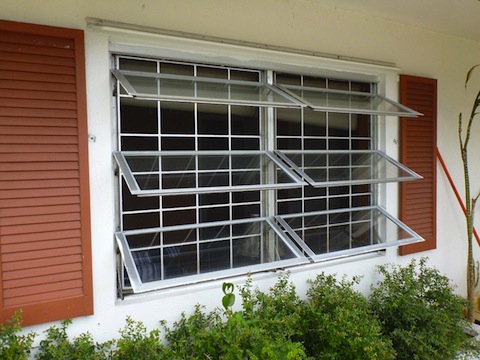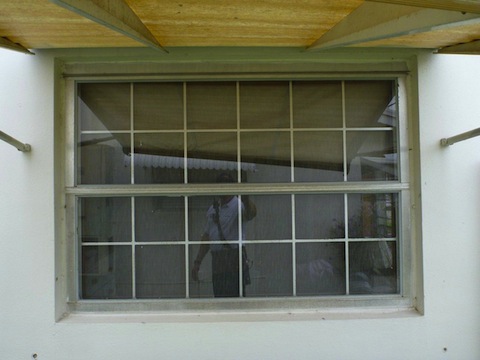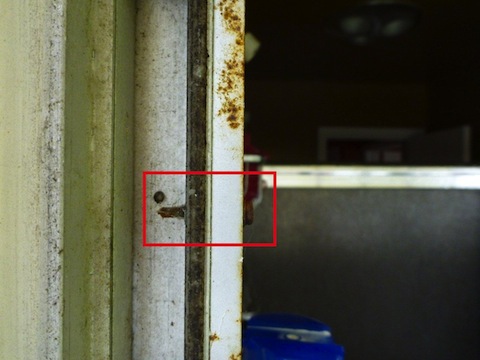
Captain Rick Cravero from Tamarac (FL) sent in these photos of security bars on the inside of windows from a local neighborhood. When the windows are shut, the bars appear to look more like french window panes instead of security bars. One thing that may give it away is that in this particular case, is that not many jalousie windows had french panes.


These particular bars are simply held in place by some self-tapping screws into the original window frame. These bars may slow us down a little, but shouldn’t be much of a match to a determined firefighter. Depending on how the window frame is secured (how many screws were used), pulling on the bars may remove the entire window frame. If the window frame is well secured, then inserting either the fork or the adz of the halligan in between the window frame and the security bar assembly to separate the bars from the window frame would speed up the removal. Once the frame of the bar assembly is weakened and separated from the frame in a few places, the entire bar assembly should be able to be “hinged†away from the window opening. The rotary saw always remains an option, but believe it or not, the hand tools may end up being quicker.
The main thing to consider when faced with bars is to remove them early! Waiting until conditions deteriorate, or worse, when a fellow firefighter needs to bail out is not what we should be doing. Trying to minimize damage to the structure by waiting to remove them may actually cause more damage in the end. Simply open it up, and get the job done!

where can a get ones that Rick Cravero submitted? I live in Tamarac also.
Just a thought, how about borrowing an idea from the other guys that specialize in forcible entry on “hardened” structures, the cops/SWAT. I was watching something on TV, and they were tweaking a grab with attached to chain, that was attached to a barred window, to a vehicle (or several for multiple windows) and removed simultaneously to gain entry. Could something like this aid in the speedy removal of fortified windows for our purposes also, coincidental venting issues aside? Perhaps attached to a supervisors SUV or a rigs hook and either pulled directly or attached to a come-along?
Regards, Jim
Regards, Jim
Speaking from the flip-side of my life story coin, that’s a problematic thing to say the least. I was a demolitions and breaching instructor in the 75th Ranger Regiment and generally speaking, the people I was tasked with introducing myself to were significantly less happy to see me than a drug dealer who just had a SWAT truck screech to a stop in front of his house. Bars were something we had to contend with, as well as reinforced walls, etc. Breaching a fortification is a complicated thing, and that’s what bars are.. a fortification of a property.
While winching off a rescue winch, come-along, or chaining off to Apparatus of whatever sort seems like it would be a quicker thing to do… Visualize a fireground scene.
We set up so our largest piece of apparatus can access at least 2 sides of the building (Truck) and 20 feet or less in front of it we’ve got another large piece of apparatus (Engine). Your SOP/SOG may vary, but the unignorable fact is we have big trucks parked right in front of what we need to breach, and we can’t move them (outriggers, pump, fire suppression, bla bla. Not moving once positioned!)
That means that using a command vehicle to try to do the drive and yank is a no-go due to hoselines, apparatus, and general fireground activities that commonly occur regardless of the scene.
Couple that with most SUV’s being sold today and used as CV’s not having a whole lot of OEM recovery points built in, and the ones that are stock are typically an afterthought. Dragging something off the building would work well with chain and an actual Apparatus, but that is a problem because of the >50 feet of the A side of the building we’ve got blocked with effectively immobilized apparatus. While aftermarket solutions (Warn/Buckstop/Ranch Hand) provide good sturdy recovery points and/or winch mounting, you still have the issue with actual access TO the building… and most departments at best put a Setina or the like push bumper on the front… which isn’t designed to be pulled from. I’m sure we’d all like to explain how we ripped the front of a CV off to whomever we report to.
That means now, your only real option to do a winch or come-along bar removal evolution is to have a “Rescue Engine” like the one I work on, which has side reciever points for use with a portable winch. While it’s becoming more common for this to be a feature built into newer apparatus, this also means the only side that you can be able to do this “breaching evolution” is on the A side of the building.
With a full 6 man crew on an Engine or Truck? 2 in 2 out Engineer on the pump and Officer as initial IC… nothing says the 2 out can’t be tasked to something, you just want them to be able to drop what they’re doing to be able to help the 2 in, if necessary. One FF grabs the winch, one grabs the chains. Toss the winch in the receiver, flip to free spool. Chain man takes the hook and goes to the window and chains and hooks up. Winch man’s plugging in the winch to the apparatus, remote to the winch, and eyes on the chain man. Thumbs up, Chain man clear, winch man engages the spool and winches away. It could be done very quickly if identified on arrival.
The problem we’d run into is that most fortifications like window bars, additional locks, etc… are on the BCD sides of a building because those have more limited visibility and therefore are more of a target for entry by a thief. Exactly where we can’t use our winch plans.
Could you use “The Stick”? If you have a platform with points you could attach to and a good bucket load? Acknowledging that most residential properties end up having issues getting the aerial into action due to power lines, maybe. Big things would be pre-hooking a “droop chain” to the bucket, positioning it over where you wanted to breach, and going slow with noone IN the bucket since it’s going to jump and wobble once the bars come out… then you have a pendulum of steel bars swinging around. The more I think about even trying that, the more my Chief’s voice in the back of my head is saying “I will murder you if you even try it” so we’ll just say “Bad Idea”.
My personal belief is that we’re doing this as quickly and safely as possible by using the K12 or other hand tools to conduct the removal of the bars. One tool that might prove to be a smidge quicker would be E-Draulic cutters, or even manual hydraulic cutters, since you could generally be able to pinch and take 2+ bars out at the same time in the event you encountered the same design as what’s in the pictures. Wider bars, you’d have to go one at a time… but if you DO have the manpower, there’s nothing I see WRONG with one FF taking one side with a K12 and the other being taken by a FF with E-draulics, provided you do it carefully and with competent trained personnel.
One last thought is something I’m honestly not completely knowledgeable about, and that would be the structural integrity component of a window frame. One method that MAY be quicker would simply be to conduct a plunge followed by crosscut below the windowsill, then complete the box, with a chainsaw. Windows that are taken out are commonly “turned into doorways” by cutting the sill and wall down to the floor, but I know that most windows are framed on the sides with structural members, if not reinforced to take the loading from the “structural gap”.
I know I can cut wood quicker than steel though, then all it takes is having a strap tied off to the top to yank and pull it out of your “new bay window” and you’d have a great egress point from the structure, plus horizontal ventilation.
SWAT has the advantages of being able to pre-plan a single operation with significantly less “hip pocket adaptation” than what We as Firefighters can rely on. SWAT also has significantly more manpower and can dedicate specific personnel to one single task (breach that window then shoot anything coming out) than we can. They don’t have the issues with physical access to even the A side, because they can roll up with their SWAT vehicle straight to the front door, dismount from the sides, hook up then slam the truck into reverse… and chances are, it’s at least a K2500 suburban, if not an armored vehicle designed to be able to do that sort of thing. They have advantages for that type of situation that we don’t, and generally speaking they WANT the bars to stay on, for the simple fact that they WANT the building to constrain and contain. They’re only concerned with making access quickly and at one point for the most part due to safety with fields of fire for both themselves and the public.
Stay safe.
^^^^^^Longest ves.com comment of all time!^^^^
Well, we can either have a discussion, or snarky donkey kick comments.
I’d rather have a discussion and learn from it, myself.
How ’bout a snarky discussion?
Polar Fire;
Thank you for your service, and thank you for the education. Talking out of my ass as usual, but I never heard anyone speaking of “tactical” entry techniques, and how the fire service might be able to add something to our bag of tricks, in the same discussion. Thought there might be something useful.
Regards, Jim
Not a problem. Being honest, I don’t think you were talking out of your ass in the least.
War-gaming the best methods to defeat these obstacles is paramount to getting them out of our way in the most efficient, expedient, and safe manner. Even if it’s a rare thing to encounter in our respective areas of response, having done so means that we have a tool in the mental toolbox to address a specific situation if it happens to come up.
Window bars are unheard of in my response area, other than on pawn shops or other commercial occupancies. That’s where doing a chain-and-yank might prove to be a much quicker method of removing them, since you typically have at least 3 sides access (in my area). Now your next obstacle is convincing your Chief you aren’t going to trash his CV doing it…
Another thing to consider is how some bars are installed. These interior-ish bars are basically for show more than for any real use, as seen with the screw attachment. While cutting them may seem like the right thing, it looks like you could probably knock them in or out of the way with some good swings with a sledge, flathead, or even a halligan.
Now think about the exterior bars which are more common. Sometimes the bars mounting is reinforced with steel strap around the sides of the windows, which interfaces with the bolts through the wall. A valid concern might be that while cutting the exterior bars is slower, if you went for a chain-and-yank on ones like that… you might take out more than you bargained for. Weakened structure due to the fire, you straight rip out an entire window with a shock load to the structure to boot. Would you want to have a 1 or 2 story building chasing you in reverse (never mind any interior crews demise)? Not saying it WOULD happen… but there’s enough LODD’s across the board from not planning for what COULD happen.
Sir;
Thanks for the follow up. I appreciate your taking the time.
I know nothing about tactical entry thought or techniques, was just wondering if any would be worth adding to our repertoire. Again much appreciated.
Regrades, Jim
We get ropes into doing community pr garbage and they use us so people will open the door. One city hall dweller went around telling people to get these inside the window bars. When I asked her why and pointed out the various problems that these bars suggest she seemed dumbfounded.
We have encountered these more than a few times. The fastest way through these, whether set in CBS or in wood frame, is 1. take the glass and don’t worry about the frame at first, 2. locate the pins or screws securing it to the structure, 3. straddle the security bar closest to each pin with the forks of the halligan, 4. strike several times (perpendicular force always wins), 5. repeat until all pins or screws are defeated (usually 2-4 points of attachment). NOTE: In CBS, they usually are not attached at the top…they are set in with pins that slide into pre-drilled holes. If you don’t take steps to secure the bars, they may wind up falling clear and in…on top of a victim.